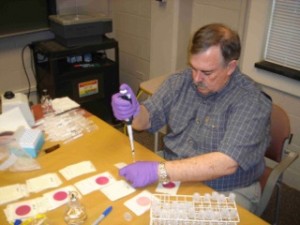Cleaning Science
[fbshare type=”button”]
[linkedin_share style=”none”]
[twitter style=”horizontal” float=”left”]

From the February 2012 issue of The Cleaning Gazette
What is mankind’s greatest invention? Is it our built environment?
Man’s oldest invention and one that every human enjoys to some extent is the protective built environment. Humans liberate themselves from the unfavorable effects of the natural environment by an ability to construct and maintain a protective environment. We maintain shelter against enemies including weather, extreme climate, storms, predators, disease, and exposure by the habitats we build, maintain, and clean.
The primary human habitat is a built environment and a sub-compartment of the natural environment. This built environment is the environment most humans occupy more than 90 percent of their time. It dominates the quality of human life and health. It is the environment over which we have the most control. The most important control is primarily through the process of cleaning.
Cleaning is a Science
To understand the important role of cleaning and the contributions it makes to human existence, we need to know three things:
- What is cleaning?
- How does it it work?
- Why it is important?
Cleaning science includes several subjects . They must be properly understood if we are to understand the field of cleaning and its impact on health? To properly discuss “cleaning,” we must emphasize the objectives and reasons for cleaning. We must also understand and emphasize their importance and value. The science of cleaning includes the following topics:
[ordered_list style=”decimal”]
1. Effective Cleaning Reduces Risk.Cleaning creates a healthy condition by reducing exposure and risk. It enables sanitation, it breaks the chain of infection and prevents illness. In addition to human health, cleaning protects valuable materials and equipment and maintains the value of property. Cleaning is insurance that prevents crisis and reduces the full range of costs related to property and real estate. Cleaning also manages waste and contributes to environmental protection and sustainability.
2. Chemistry of Cleaning. Many aspects of cleaning are based on chemical action. Knowing how chemicals work is fundamental to cleaning. The effect they have on various forms of matter, their protective or risk-reduction benefits , the toxic, unwanted, or unintended effects on humans or the natural environment are all important parts of cleaning science.
3. Cleaning in Special Environments. Cleaning is the organized process of removing or repositioning unwanted matter so human activities can take place in a particular built environment. Different environments require different cleaning processes.
4. Measuring Cleaning Effectiveness.Cleaning is measured in terms of the quantity of unwanted matter removed. Dr. Berry’s 2006 study at the University of North Carolina showed that effective cleaning when consistently implemented is cost effective and can lead to measurable environmental improvements as measured by reductions in particles, volatile organic compounds (VOCs), and biological pollutants. The assessment of cleaning effectiveness can be accomplished through process audits, environmental sampling and measurement of dusts, fungi, bacteria, and indoor-air particulate matter. Sampling and measurement answers the question, “What happens when you clean?”
5. Determining Cleaning Data. In recent years, there have emerged comprehensive programs for efficacy testing of cleaning processes, products and technologies. Too frequently, limited or unsubstantiated claims are made with regard to the attributes of specific cleaning products. In the absence of process or systems testing, these claims cannot be validated. Without testing, tracking effectiveness, outside auditing of environmental sustainability, human activities may be polluting the built environment rather than cleaning it.
6. The Professional Language of Cleaning. Every profession and science has a unique vocabulary. A language, a set of definitions, concepts, and terms. For cleaning to truly become a professional, science-based industry recognized by government, health organizations, and other critical constituents, the language of cleaning science must be organized in a systematic manner. This includes seeing cleaning terminology in its proper hierarchy; agreeing on terms; and thereafter publishing and accepting those terms as norms. Antiquated cleaning and maintenance terms should be reviewed, assessed, rejuvenated, or rejected and replaced.
7. Cleaning Management. Effective cleaning starts with educated management competency, professionalism, and technical leadership. A well-managed and effective cleaning program includes the following quality-management components: process identification, evaluation, and continuous improvement; management by fact and knowledge for improvement; structured problem solving; effective communication at all levels; valuing human resources; benchmarking and performance measurement; and quality tools and technology. The effectiveness of the cleaning program resides in a well-defined and comprehensive cleaning objective; planned, scheduled, systematic cleaning workloading; the use of specialized, benchmarked cleaning equipment and technology that is tested and evaluated for effectiveness, best practices and safety. Most importantly there needs to be a focused and specialized basic and inservice training provided to the cleaners.
[/ordered_list]
Cleaning for health first, to be an achievable goal, demands that our industry have a firm foundation in science. It is only through this process—of benchmarking, auditing, disciplined research, critical peer review, and open presentation—that the cleaning industry will receive the recognition it deserves as a science-based profession that is not only focused upon, but able to provide, a healthy indoor environment.
